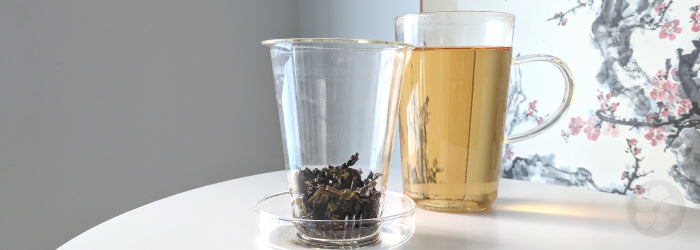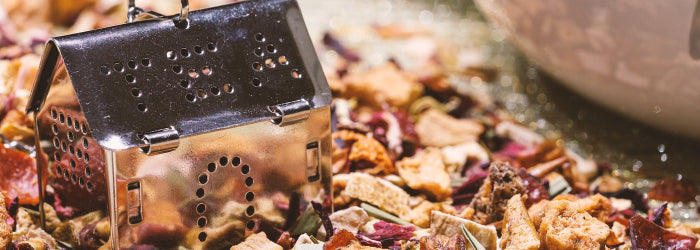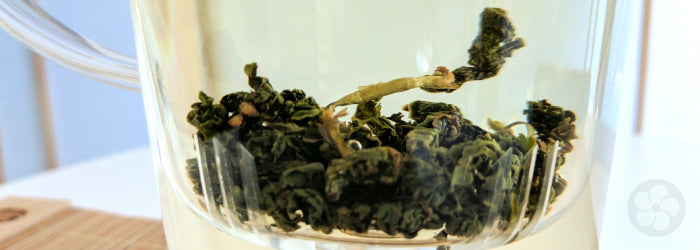The Ultimate Guide to Tea Infusers

Tea infusers, made to contain tea leaves while brewing, are an extremely popular tool for brewing loose leaf tea. A precursor to bagged teas, reusable infusers hold leaves captive while allowing water to flow freely through a filter of mesh or punched holes. They are particularly useful for brewing small leaf pieces, like those used for many Western-style black teas, because they prevent small bits from ending up in the brew. However, they’re also commonly used for other tea types, since they are easy to find, simple to use, and allow for leaves to be extracted to prevent over-brewing.
Find strategies to brew tea without an infuser >>
In fact, styles of tea infusers seem nearly endless, with variations in shape, material, filter size, and intended methods of use. In the broadest sense, many teapots can even be considered infusers in and of themselves, especially if they include some sort of filter to keep leaves from clogging the spout. Ultimately, the best infuser depends on the material, the shape and size, and most of all, the type of tea that will be brewed in it.
Materials
The material an infuser is made of can have a big impact on the flavor of the resulting brew, especially if it has a reactive or porous surface. The best material depends on the particular balance of durability and flavor neutrality required, given where, how, and with what teas it will be used.
Metal
Metal is probably the most popular material for infusers of any style, since it is highly durable and easy to mold into many shapes with a variety of strainer holes. Metal mesh is particularly common in Western markets, and is often preferred for chopped or broken-leaf teas. Unfortunately, metals are reactive, and can make a big impact on delicate or highly nuanced flavors. Mesh can also be difficult to clean well, and metal infusers can quickly become stained with dark tannins or take on the flavors of strong teas.
Released to public domain by owner. via Unsplash.
Plastic and Silicone
Modern infusers often use plastic, primarily for aesthetic reasons. Silicone is used for many novelty-style tea infusers, especially those molded in cute and whimsical shapes. Punched holes are usually as small as possible, replicating metal mesh to allow for the use of small leaf pieces. Plastic infusers can also affect the flavor of many teas, and are best purchased from reliable suppliers to avoid toxins like BPAs.
Ceramic
Clay mugs intended for tea often come with matching infuser baskets, made to fit perfectly in the cup. While a coating of glassy glaze usually makes these infusers neutral in flavor and resistant to staining, crafting methods make it hard to create very fine straining holes. Thus, ceramic infuser baskets are usually better suited for brewing whole-leaf teas. They are also more fragile than metal or plastic, and harder to replace, since they are usually made along with a mug or pot.
Glass
Some infuser baskets are made completely from glass, for complete flavor neutrality. Laser-cutting allows for fine straining slits that keep leaves of all sizes contained. Like ceramic infuser baskets, these are typically also made with a mug or teapot, and must be properly sized. Glass infusers might seem more delicate or fragile than bulkier ceramic ones, but high quality versions that don’t skimp on material are surprisingly durable. Like the glaze used on ceramics, glass also resists stains, making these infusers easy to clean.
Watch Alice demonstrate how to use our Glass Infuser Mug:
Shape
Shape and size are the other main consideration when buying a tea infuser. While smaller infusers can be more versatile, and used with many different brewing vessels, larger shapes usually produce better flavor.
Ball Infusers
Most common in western brewing, ball-shaped infusers use a latch or clamp mechanism to hold tea leaves while they are submerged in the brewing vessel. Metal mesh versions are by far the most popular. Originally, these tools were used for infusing spices in British culinary tradition, but as tea became a national habit, they were repurposed to hold the small leaf pieces of imported black teas.
Released to public domain by owner. via Unsplash.
They remain popular today, particularly since they can be used with any brewing vessel. However, the small size of these ‘tea balls’ doesn’t allow tea leaves much space to circulate in the hot water, and can restrict the expansion of larger leaves as they rehydrate. For both these reasons, they’re generally best reserved for chopped tea leaves or finely ground herbal infusions.
Learn more about the difference between whole and chopped tea leaves >>
Novelty Shapes
As mentioned above, whimsical shapes are common variations on the tea ball. With some sort of latch to keep them closed, tea can be steeped inside cute sea animals, lounging figures, or almost anything else you can imagine. Typically, these fun tea accessories are made of plastic or silicone, and made to be submerged in any vessel while the tea brews.
Released to public domain by owner. via Pixabay.
They present many of the same challenges as tea balls, as well. Leaves can be restricted, plastic can take on the flavor of strong tea or spices, and even the material itself can make a difference in the flavor of delicate teas. In addition, more complex designs can separate the shape into even smaller portions that can trap leaves and restrict water flow even more than a standard mesh ball, and be harder to clean afterward.
Baskets
Most popular among drinkers of whole leaf tea, basket-shaped infusers usually fit neatly in the top of a brewing vessel and allow more space for leaves to circulate while steeping. To maximize circulation, the basket should be as deep as possible. Metal mesh is still the most common material. Some mesh baskets are designed with wide flanges at the top that allow them to sit atop any mug, but these are rarely deep enough to accommodate expanding leaves, and are best used for straining brewed tea.
Released to public domain by owner. via Unsplash.
Other baskets, made of metal, ceramic, or glass, are made to fit a specific pot or cup, and accommodate a lid that helps maintain a steady temperature while brewing. This type of infuser is ubiquitous in brewing tools made in Asia, as most tea drinkers there are accustomed to using whole leaves, herbs, or flowers that need more room to expand in the cup.
A few variations on the basket design are also relatively common among whole-leaf tea drinkers. Some are made to hold the leaves while brewing, then sit atop a mug and decant through a mesh filter at the base at the press of a button. (Unfortunately, these are usually made of plastic.) The options are seemingly endless, but we prefer to invest in high quality tea leaves rather than fancy brewing gadgets.
When to Use an Infuser
No matter what style, tea infusers are typically used in larger brewing vessels, and therefore produce more dilute flavor than traditional brewing tools. To us, their primary advantage is convenience, while focused tastings are better performed with a smaller volume of water. However, there are a few situations where we usually prefer to use infusers rather than traditional teaware.
Brewing while working
Though it’s not impossible to brew gong fu cha at a work desk, infuser mugs are much more convenient for simple solo drinking. As a self-contained vessel, there is no need for a tray to catch spills while pouring, and fewer dishes overall to clean at the end of the day. And while a traditional brewing setup can provide a welcome break between work tasks, we’re rarely focused on the nuances of flavor while we sip at our computer.
A large, deep basket made of ceramic or glass is best in this situation, to make the most of high quality leaves by giving them plenty of room to circulate and expand. We also prefer a mug with a flat-topped lid that can easily function as a coaster to hold the wet basket between brews.
Brewing for a group
For groups larger than 6 or 8 people, brewing in small, traditional teaware becomes a difficult balancing act. It can be even more challenging if tea is not the focus of the gathering. For most big parties, we prefer to use a large pot with a deep infuser basket to ensure everyone can have the freedom to leave the tea table with a larger cup.
Infuser baskets make it easy to maximize the quantity of tea brewed from each serving of whole leaves with multiple infusions, since the contained leaves can be extracted from the hot water and set aside before being brewed again. Glass or glazed ceramic baskets with a large opening are also simple to clean and ideal for brewing multiple teas in a row.
Find more strategies for brewing for large groups >>
Travel brewing
Most travel thermoses designed for tea have some sort of filter designed to contain leaves while brewing on the go. While those made for the Western market are usually made to allow leaves to be extracted from the water, Chinese designs typically include a shallow filter that simply holds tea leaves away from the drinker’s mouth, otherwise allowing them to flow freely in the body of the thermos.
See how we use our travel tea thermos in this video:
Travel brewing is one area where we prefer metal over glass or ceramic for durability, though we still prefer a thermos that uses as little metal and plastic as possible. To increase nuance and avoid bitterness, we often use low-temperature water in our travel thermoses - lukewarm if we need a quicker brew, but a cold brew prepared the night before can be even better.
Brewing finely chopped leaves
For herbal infusions, English-style black teas, or many Japanese green teas, some sort of fine strainer is essential brewing equipment. While we don’t mind consuming occasional leaves, teas with ground spices like Chai blends, or even just very small leaf pieces can easily slip through larger filters, including punched-hole infusers. The result can be bitter, astringent, or downright gritty.
Released to public domain by owner. via Pexels.
For strong herbal blends, our true preference is for empty tea bags that can be filled on demand, like our Biodegradable Japanese Bags. The cotton filter is even more effective than metal mesh, and disposable options avoid the issue of absorbed flavors. Fine teas with small leaf pieces can be brewed effectively in a laser-cut glass infuser for easy containment, or alternatively strained as they are poured from a pot with a shallow metal strainer. The transient pour diminishes flavor impact, while still keeping small bits out of the serving or drinking vessel.
Overall, infusers are an easy, convenient way to make tea. Despite some disadvantages in versatility and durability, we most often recommend a large basket made of ceramic or glass over smaller infusers made of metal or plastic. Ultimately, though, the best infuser varies depending on the palate of the drinker, which teas will be brewed in it, and how it will be used.
Which type of infuser do you normally use, and when? Let us know what you think in the comments below!
Sign up for our newsletter to get blog updates in your inbox!













Comments on this post (0)